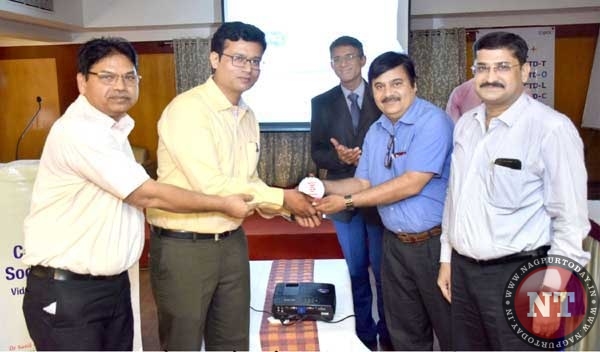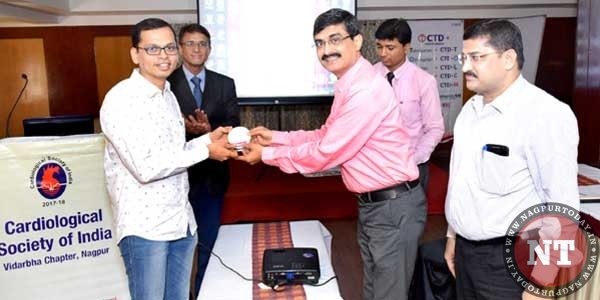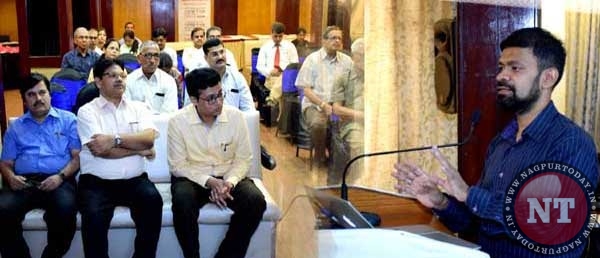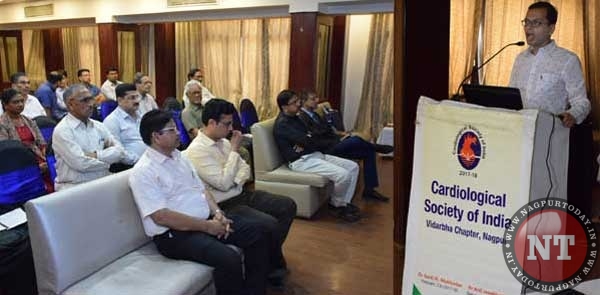
A “HYPERTENSION CONCLAVE” was organized jointly by Vidarbha Chapter of Cardiological Society of India and Academy of Medical Faculties today, Sunday, 17th of June 2018 at LB Hotel, Sadar, Nagpur.
At the outset President AMF Dr. Vinod Sukhija made Welcome Speech and highlighted the need to abreast members about latest guidelines about high blood pressure management. First talk was given on” Hypertension: What has changed after recent guidelines” by Dr. Mahesh Fulwani, Interventional Cardiologists, and M.D. of Shrikrishna Hrudayalaya. Dr. Aziz Khan & Dr. Sanjay Jain presided over the session as Chairpersons., Highlighting “Why Guidelines are needed and important” Dr. Mahesh Fulwani said, in today’s era, they provide Uniformity of treatment, evaluation of uniformity of treatment and evaluation of its effect, Medico legal reasons and is in larger interest of the society. It breaks the myth “Me and my patients are doing well”.
After a long gap of 14 years the values of BP were lowered after Sprint Trial results were out and now stand at 130/80 as Hypertension and must be attended and treatment started. 2mm Hg reduction of Diastolic BP would result in 6% reduction in risk of Coronary Heart Disease, and 15% reduction of risk in Stroke and Transient Ischemic attacks (TIA). Thus Office determination of Hypertension (High BP) is staged in 4 stages: as Normal Systolic vs. Diastolic (<120/<80mmHg), Pre-hypertension (120-139 systolic and 80 -89 diastolic). S tage I Hypertension 140-159 Systolic and 90 -99 diastolic Stage II Hypertension > 160 systolic and > 100 diastolic. But Now Americal Heart association and ACC guidelines 2017 further refined and states Normal <120 and <80; Elevated 120 -129 and <80 HT Stage I 130 -139 or 80 -89 and Stage II > 140 – > 90. He further added that larger reduction of blood pressure produce larger reduction in the risk.
The latest European Society of Cardiology (ESC) released on 9th of June, this year (2018) has endorsed <120/<80 optimal, 120 -129 /80-84 Normal; 130-139/85-89 High Normal; 140-159 / 90-99 Grade I HT; 160 – 179 and 100-109 Grade II HT & 180 & or > 110 Grade II HT; ISH > 140 and <90. Sprint trial says reduction to 120 BP lower blood pressure target brings 25% lower heart attacks, heartfailure & other Cardiovascular events and lowers 27% lower risk of death. With the new guide lines,5 things all must know are : more patients will be diagnosed as HT, more patients will need stringent counseling for HT, hence adjust treatment based on BP category and CV Risk (Using Calculator) Treatment targets for patients should be followed. And Self monitoring of BP goals should be encouraged” concluded Dr. Fulwani.
Second Lecture was delivered by Dr. Shantanu Sengupta, Director & Consultant Cardiologist Sengupta Multi speciality Hospital; on “Ambulatory Blood Pressure Monitoring as standard care” It was presided over by Dr. Ram Ghodewsar and Dr. Nitin Khandelwal. Dr S. Sengupta said no other biological variable is except advancing age predicts cardiac risk better than ventricular hypertrophy. And the most common cause of Left Ventricular Hypertrophy (LVH) is uncontrolled Hypertension. Single reading in clinic cannot give idea as BP can be influenced by Doctor (White Coat HT),, Nurses, surrounding noise levels, passing of vehicles, and not necessarily to same extent in all cases, and varies as per circadian variation, Other factors affecting BP are Age, Sex, stress and emotional changes, and also effect of gravity (As seen in astronauts) Several succession recordings as done by the continuous Ambulatory Blood Pressure monitoring (ABPM) one can diagnose the type of hypertension and initiate appropriate measures from lifestyle modification, n on drug and pharmacotherapy as the case may be and counsel the patients.
Wearing the machine on arm and continuing normal activities and reading the recordings is the best way to know the status of Blood pressure. BP drops during sleep by 15%, But in certain patients it does not drop by 10% are called non dippers and has metabolic reasons and some evidence that melatonin plays a role. ABPM is recommended in High Risk group such as ongoing hypertensive treatment, High Normal BP (130-139/ 85 -89 mmHg; Obesity/Diabetes Mellitus/ Metabolic syndrome/CVD/ increased drinking /stress/ physical activity/ heart rate; abnormal orthostatic changes in BP; Organ damage.
Next talk was delivered by Dr. Shoeb Nadeem, Interventional Cardiologist, Alexis Hospital, on “Hypertension and Co Morbidities” and was chaired by Dr. P.P.Deshmukh and Dr. Shankar Khobragade. He discussed HT in Diabetes, Chronic Kidney disease, Atrial Fibrillation, and Obstructive Sleep Apnea. Dr. Shoeb Nadeem said DM and HT make a dangerous combination. It increases the risk of atherosclerosis and cardiovascular disease. In Type 1 Dm it is caused by underlying of kidney disease. In type II Diabetes it coexists with cardiometabolic risk factors. HT is twice more common in DM than non-diabetics. They commonly present with isolated systolic hypertension and are resistant to treatment. The target for Diabetics is 130/80 in non-proteinuric diabetic patients. He stated various trials and stated what difference exists in Diabetes. Lower BP compromises the blood flow to vital organs when BP touches a critical low point.
Meta-analysis of 49 trials including 73, most of them diabetic) Bp value greater than 140 mmHg, BP reduction was associated with decreased in mortality and CV morbidity. BP reduction in patients with initial BP values <140mmHg resulted in increased CV mortality and tendency towards increased overall mortality. Tight control of BP and Sugar resulted in decreased stroke, any diabetic end point, DM deaths, microvascular complications. He late discussed chronic kidney disease, atrial fibrillation and sleep apnea and how to treat HT. HT and co-morbidities go hand in hand. Treatment has to be individualized according to clinical scenario. One size fits all concept can’t be realized in medicine.
Last lecture was given by Dr. Pankaj Harkut on the management of Resistant Hypertension, and presided over by Dr. Pramod Mundra. Dr. Harkut said, Refractory Hypertension is part of resistant Hypertension when 5 or more anti- hypertension drugs fail to control the BP. Hypertension classification also is based on blood pressure control and number of anti hypertension : controlled, uncontrolled, controlled resistant, and refractory. Resistant hypertension prevalence is variable from 9%to 18%. It is multifactorial, there is interplay of an enhanced sympathetic tone and fluid retention, aldosterone has an important role, hyperenhanced adrenergic state is present along with impaired baroreflex activity, prevalence of secondary HTN in patients referred for resistant HTN is likely higher. It is important to screen secondary causes of HTN. If you manage simple hypertension you will manage resistant hypertension well concluded Dr. Pankaj Harkut.
The Conclave was largely attended by members of both organizations and aroused interactive discussions.
Maharashtra Medical Council (MMC) had accredited the CME and granted 1 credit point. Dr. Prashat Joshi was MMC Observer and was felicitated by Hon Secretary CSI, Dr. Anil Jawahirani who conducted the scientific proceedings and also proposed the vote of thanks















